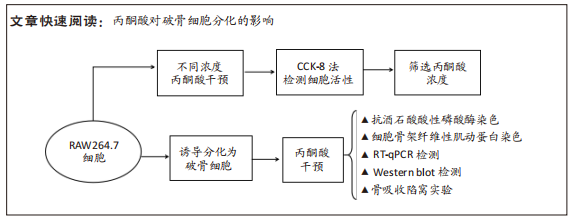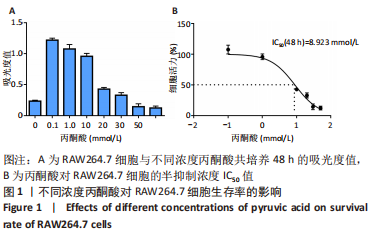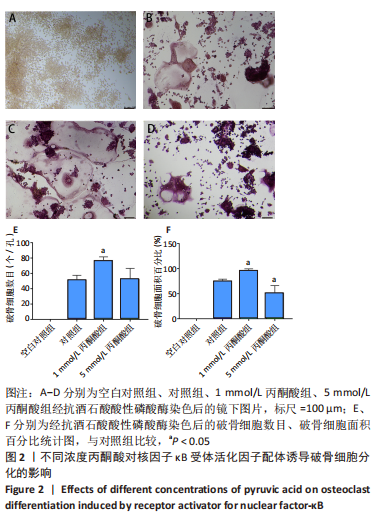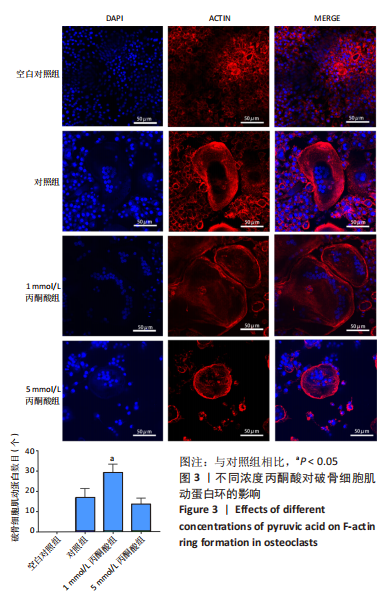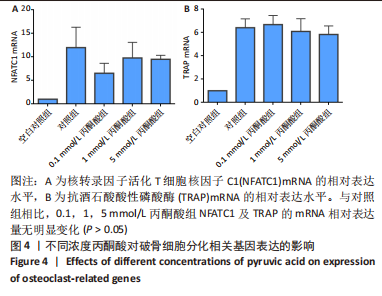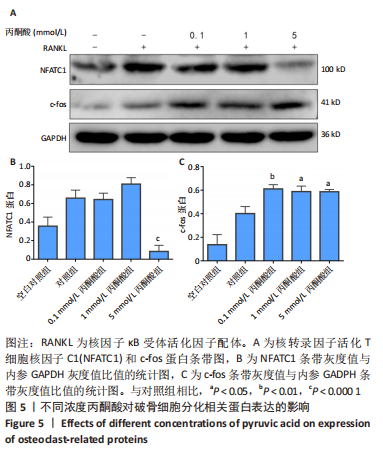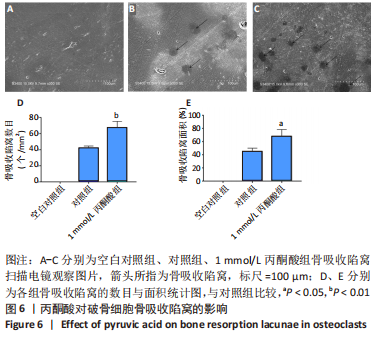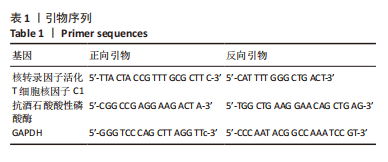[1] SUZUKI A, MINAMIDE M, IWAYA C, et al. Role of Metabolism
in Bone Development and Homeostasis. Int J Mol Sci. 2020;21(23): 8992.
[2] UDAGAWA N, KOIDE M, NAKAMURA M, et al. Osteoclast differentiation by RANKL and OPG signaling pathways. J Bone Miner Metab. 2021; 39(1):19-26.
[3] IKEDA K, TAKESHITA S. The role of osteoclast differentiation and function in skeletal homeostasis. J Biochem. 2016;159(1):1-8.
[4] LEMMA S, SBOARINA M, PORPORATO P E, et al. Energy metabolism in osteoclast formation and activity. Int J Biochem Cell Biol. 2016;79:168-180.
[5] KANAZAWA I. Interaction between bone and glucose metabolism [Review]. Endocr J. 2017;64(11):1043-1053.
[6] PARK-MIN KH. Metabolic reprogramming in osteoclasts. Semin Immunopathol. 2019;41(5):565-572.
[7] KARNER CM, LONG F. Glucose metabolism in bone. Bone. 2018;115: 2-7.
[8] LI B, LEE WC, SONG C, et al. Both aerobic glycolysis and mitochondrial respiration are required for osteoclast differentiation. Faseb J. 2020; 34(8):11058-11067.
[9] 丛林,朱静华.丙酮酸盐的功效和使用[J].田径,2022(2):84.
[10] 李敏,马凌云,陈超阳,等.丙酮酸钠药理学作用的研究现状[J].中国临床药理学杂志,2021,37(3):341-344.
[11] LUO Z, ZENG W, DU G, et al. Enhancement of pyruvic acid production in Candida glabrata by engineering hypoxia-inducible factor 1. Bioresour Technol. 2020;295:122248.
[12] KAO KK, FINK MP. The biochemical basis for the anti-inflammatory and cytoprotective actions of ethyl pyruvate and related compounds. Biochem Pharmacol. 2010;80(2):151-159.
[13] FUKUSHIMA M, LEE SM, MORO N, et al. Metabolic and histologic effects of sodium pyruvate treatment in the rat after cortical contusion injury. J Neurotrauma. 2009;26(7):1095-1110.
[14] INDO Y, TAKESHITA S, ISHII KA, et al. Metabolic regulation of osteoclast differentiation and function. J Bone Miner Res. 2013;28(11): 2392-2399.
[15] 王银博,孙维佳,李玉恒,等.破骨细胞能量代谢的研究进展[J].中国骨质疏松杂志,2022,28(1):139-142.
[16] MOTYL KJ, GUNTUR AR, CARVALHO AL, et al. Energy Metabolism of Bone. Toxicol Pathol. 2017;45(7):887-893.
[17] 张晓丽.谷氨酸与丙酮酸对星形胶质细胞耐受氧化应激的影响[D].福州:福建医科大学,2021.
[18] ZENG X, ZHANG Y, WANG S, et al. Artesunate suppresses RANKL-induced osteoclastogenesis through inhibition of PLCγ1-Ca(2+)-NFATc1 signaling pathway and prevents ovariectomy-induced bone loss. Biochem Pharmacol. 2017;124: 57-68.
[19] ASAGIRI M, SATO K, USAMI T, et al. Autoamplification of NFATc1 expression determines its essential role in bone homeostasis. J Exp Med. 2005;202(9):1261-1269.
[20] CHEN Z, DING M, CHO E, et al. 2-NPPA Mitigates Osteoclastogenesis via Reducing TRAF6-Mediated c-fos Expression. Front Pharmacol. 2020;11:599081.
[21] BAEK JM, KIM JY, LEE CH, et al. Methyl Gallate Inhibits Osteoclast Formation and Function by Suppressing Akt and Btk-PLCγ2-Ca(2+) Signaling and Prevents Lipopolysaccharide-Induced Bone Loss. Int J Mol Sci. 2017;18(3): 581.
[22] ASAGIRI M, TAKAYANAGI H. The molecular understanding of osteoclast differentiation. Bone. 2007;40(2):251264.
[23] 王瀚,曹新生,张舒.破骨细胞体外培养技术[J].中国骨质疏松杂志,2014,20(11):1284-1289.
[24] AHN H, LEE K, KIM JM, et al. Accelerated Lactate Dehydrogenase Activity Potentiates Osteoclastogenesis via NFATc1 Signaling. PLoS One. 2016;11(4):e0153886.
[25] TIEDEMANN K, LE NIHOUANNEN D, FONG JE, et al. Regulation of Osteoclast Growth and Fusion by mTOR/raptor and mTOR/rictor/Akt. Front Cell Dev Biol. 2017;5(18):54.
[26] KOH-BANERJEE PK, FERREIRA MP, GREENWOOD M, et al. Effects of calcium pyruvate supplementation during training on body composition, exercise capacity, and metabolic responses to exercise. Nutrition. 2005;21(3):312-319.
[27] HU S, MA L, LUO HM, et al. Pyruvate is superior to reverse visceral hypoperfusion in peritoneal resuscitation from hemorrhagic shock in rats. Shock. 2014;41(4):355-361.
[28] HIDVéGI M. Inhaled Nebulized Sodium Pyruvate Use in COVID-19 Patients. Isr Med Assoc J. 2020;22(5):278.
[29] 刘翔宇,柴家科,刘甜,等.口服丙酮酸钙盐糖液对重度烧伤大鼠伤后早期氧合脏器功能及生存率的影响[J].解放军医学院学报, 2021,42(8):836-842+856.
[30] LI Y, CHEN J, LUN SY. Biotechnological production of pyruvic acid. Appl Microbiol Biotechnol. 2001;57(4):451-459.
[31] LUO B, ZHOU X, TANG Q, et al. Circadian rhythms affect bone reconstruction by regulating bone energy metabolism. J Transl Med. 2021;19(1):410.
[32] ZHANG HY, TAN XX, KANG K, et al. Simultaneous determination of lactic acid and pyruvic acid in tissue and cell culture media by gas chromatography after in situ derivatization-ultrasound-assisted emulsification microextraction. Anal Bioanal Chem. 2019;411(3):787-795.
[33] KIM JM, JEONG D, KANG HK, et al. Osteoclast precursors display dynamic metabolic shifts toward accelerated glucose metabolism at an early stage of RANKL-stimulated osteoclast differentiation. Cell Physiol Biochem. 2007;20(6):935-946.
[34] 林璐,顾玉婷,陆尔奕.糖酵解与骨代谢关系的研究进展[J].口腔材料器械杂志,2020,29(3):168-172+180.
[35] FONG JE, LE NIHOUANNEN D, TIEDEMANN K, et al. Moderate excess of pyruvate augments osteoclastogenesis. Biol Open. 2013;2(4):387-395.
[36] SONG C, YANG X, LEI Y, et al. Evaluation of efficacy on RANKL induced osteoclast from RAW264.7 cells. J Cell Physiol. 2019;234(7): 11969-11975.
[37] TAKAYANAGI H. RANKL as the master regulator of osteoclast differentiation. J Bone Miner Metab. 2021;39(1):13-18.
[38] KODAMA J, KAITO T. Osteoclast Multinucleation: Review of Current Literature. Int J Mol Sci. 2020;21(16):5685.
[39] TAKAYANAGI H, KIM S, KOGA T, et al. Induction and activation of the transcription factor NFATc1 (NFAT2) integrate RANKL signaling in terminal differentiation of osteoclasts. Dev Cell. 2002;3(6):889-901.
[40] SHI Y. The investigation of energy metabolism in osteoblasts and osteoclasts. Hua Xi Kou Qiang Yi Xue Za Zhi. 2021;39(5):501-509.
[41] JIN Z, KHO J, DAWSON B, et al. Nitric oxide modulates bone anabolism through regulation of osteoblast glycolysis and differentiation. J Clin Invest. 2021;131(5):e138935.
[42] WANG Y, VAN ASSEN A HG, REIS CR, et al. Novel RANKL DE-loop mutants antagonize RANK-mediated osteoclastogenesis. Febs J. 2017; 284(15):2501-2512.
[43] XIXI Z, QIAN P, WANG B. Electrolyzing lactic acid in situ in fermentation broth to produce pyruvic acid in electrolysis cell. Appl Microbiol Biotechnol. 2019;103(10):4045-4052.
[44] GRAY LR, TOMPKINS SC,TAYLOR EB. Regulation of pyruvate metabolism and human disease. Cell Mol Life Sci. 2014;71(14):2577-2604.
[45] ŽIŽKOVá R, HEDVIČáKOVá V, BLAHNOVá VH, et al. The Effect of Osteoblast Isolation Methods from Adult Rats on Osteoclastogenesis in Co-Cultures. Int J Mol Sci. 2022;23(14):7875. |
